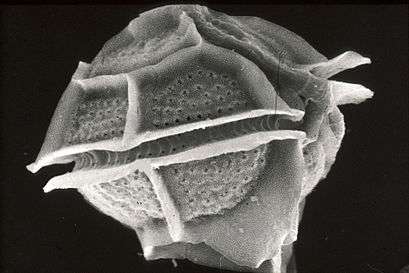Pyrodinium bahamense
| Pyrodinium bahamense | |
|---|---|
| Scientific classification | |
| Domain: | Eukaryota |
| (unranked): | SAR |
| Phylum: | Dinoflagellata |
| Class: | Dinophyceae |
| Order: | Gonyaulacales |
| Genus: | Pyrodinium |
| Species: | P. bahamense |
| Binomial name | |
| Pyrodinium bahamense Plate | |
Pyrodinium bahamense, considered the sister taxon to Alexandrium, is a tropical euryhaline dinoflagellate found mainly in the Atlantic ocean.[1] It is found in marine waters that have more than 20 psu of salinity and are warmer than 20 °C (68 °F). The optimal salinity is considered to be around 35 psu.[2] P. bahamense has only been studied closely since the 1990s, since it was difficult to culture in labs for study before then. The difficulty of culturing P. bahamense is explained by its specific nutrition needs. It shows optimal growth and chlorophyll levels when nitrogen levels in its environment are greater than 100 μM. It is believed that nitrogen is an important part of the synthesis of toxins in P. bahamense. P. bahamense displays bioluminescence when agitated, glowing blue.
Pyrodinium bahamense are shaped like ellipsoids, covered with thecal plates. There are also trichocyst pores on the plates, and sulcal fins found on either sides of the sulcus (morphology). In its dormant stages, P. bahamense develop spherical, double-layered cysts for protection. These cysts, called Polysphaeridium zoharyi, are similar to the resting cysts of Pyrodinium compressum and have tubular processes protruding from the outer layer.
Pyrodinium was first discovered in 1906 in the waters around New Providence Island in the Bahamas. Pyrodinium is a monospecific species with two varieties, Pyrodinium bahamense var. compressum and Pyrodinium bahamanse var. bahamense. Although it was widely believed that the compressum variety is toxic and found in the Pacific while the bahamense variety is nontoxic and found in the Atlantic, a 1972 toxic algal bloom of Pyrodinium bahamense in Papua New Guinea [3] showed that P. bahamense could also be toxic. It is known now that P. bahamense is a major cause of seafood toxicity and cause of paralytic shellfish poisoning, especially in Southeast Asia. The species is also the cause of toxicity in Central American coasts.[4] It has also been discovered that there are at least two places in the world where both varieties of Pyrodium bahamense are found together, the Persian Gulf[5] and coast of Mexico.[4] An association between Pyrodinium bahamense occurrence and mangrove forests has been suggested, although, the presence of mangrove forest is not necessarily a predictor for presence of P. bahamense var. bahamense, as it is absent in western and southern Florida Bay.[6]

References
- ↑ Usup, G., Ahmad, A., Matsuoka, K., Lim, P.T., Leaw ,C.P., 2012. Biology, ecology and bloom dynamics of the toxic marine dinoflagellate Pyrodinium bahamense. Harmful algae 14, 301-312.
- ↑ Wall and Dale, "THE HYSTRICHOSPHAERID RESTING SPORE OF THE DINOFLAGELLATE PYRODINIUM BAHAMENSE", 1969
- ↑ McLean, Dewey M., "Eocladopyxis peniculatum Morgenroth, 1966, Early Tertiary Ancestor of the Modern Dinoflagellate Pyrodinium bahamense Plate, 1906", "Micropaleontology", 1976
- 1 2 Gárate-Lizárraga, Ismael et al., "Occurrence of Pyrodinium bahamense var. compressum along the southern coast of the Baja California Peninsula", "Marine Pollution Bulletin," 2011
- ↑ Gilbert et al., "A fish kill of massive proportion in Kuwait Bay, Arabian Gulf", "Harmful Algae", 2002
- ↑ Phlips, E.J., Badylak, S., Bledsoe E.L., Cichra, M., 2006. Factors influencing the distribution and abundance of Pyrodinium bahamense in coastal ecosystems of Florida. Marine Ecology Progress Series 322, 99-115.